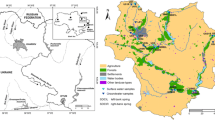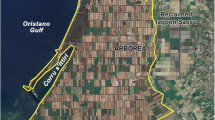Abstract
A combined hydrochemical and stable isotope approach was used to investigate the origin of nitrate in the shallow unconfined groundwater of Kharkiv city, Eastern Ukraine. The contamination was investigated in the context of land use within the catchment area. The observed enrichment of sulfate, chloride and nitrate suggests significant groundwater contamination in the shallow urban aquifer, which is widely used as drinking water source for the urban population. Characteristic nitrate/chloride ratios as well as stable isotope ratios (N and O) of nitrate in the most contaminated springs confirmed that septic waste from leaky sewer systems was the main source of nitrate contamination in the groundwater. Nitrate contamination is linked to the type of land use and sewage treatment regime in the catchment area. It is also modulated by the regional hydrogeology, which determines the susceptibility of a given aquifer toward groundwater pollution. A more quantitative assessment of nitrate sources based on the nitrate isotope analysis alone is rather difficult. However, our study confirms that the combination of hydrochemical tracers, robust land-use analysis and nitrate stable isotope measurements represents a valuable approach to identify the origin of the nitrate contamination.
Similar content being viewed by others
References
Alkhatib M, Lehmann MF, del Giorgio PA (2012) The nitrogen isotope effect of benthic remineralization–nitrification–denitrification coupling in an estuarine environment. Biogeosciences 9:1633–1646
Allums SE, Opsahl SP, Golladay SW, Hicks DW, Conner LM (2012) Nitrate concentrations in springs flowing into the lower Flint River basin, Georgia, USA. J Am Water Resour Assoc 48(3):423–438
Aravena R, Mayer B (2010) Isotopes and processes in the nitrogen and sulfur cycles. In: Aelion CM, Höhener P, Hunkeler D, Aravena R (eds) Environmental Isotopes in biodegradation and bioremediation. Taylor & Fransis Group, Boca Raton, pp 203–246
Aravena R, Evans ML, Cherry JA (1993) Stable isotopes of oxygen and nitrogen in source identification of nitrate from septic systems. Ground Water 31(2):180–186
Benson VS, Van Leeuwen JA, Stryhn H, Somers GH (2007) Temporal analysis of groundwater nitrate concentrations from wells in Prince Edward Island, Canada: application of a linear mixed effects model. Hydrogeol J 15(5):1009–1019
Böttcher J, Strebel O, Voerkelius S, Schmidt H-L (1990) Using isotope fractionation of nitrate – nitrogen and nitrate–oxygen for evaluation of microbial denitrification in sandy aquifer. J Hydrol 114:413–424
Bowen JL, Valiela I (2008) Using δ15N to assess coupling between watersheds and estuaries in template and tropical region. J Coast Res 24(3):804–813
Casciotti KL, Sigman DM, Hastings MG et al (2002) Measurement of the oxygen isotopic composition of nitrate in seawater and freshwater using the denitrifier method. Anal Chem 74:4905–4912
Cey EE, Rudolf DL, Aravena R, Parkin G (1999) Role of the riparian zone in controlling the distribution and fate of agricultural nitrogen near a small stream in southern Ontario. J Contam Hydrol 37:45–67
Cole ML, Kroeger KD, McClelland JW, Valeila I (2006) Effects of watershed land use on nitrogen concentrations and δ15 nitrogen in groundwater. Biogeochemistry 77:199–215
Dmytrenko TV (2004) Increasing ecological safety of spring waters use on the example of the kharkiv region. Manuscript of PhD thesis, Ukrainian research Institute of the Ecological Problems, Kharkiv, Ukraine (in Russian)
ECO (2015) Ecological and Environmental Passport of the Kharkiv region. Published by the Ministry of the Environmental Protection of Ukraine, p 345 (in Ukrainian)
Elisante E, Muzuka ANN (2016) Assessment of sources and transformation of nitrate in groundwater on the slopes of Mount Meru Tanzania. Environ Earth Sci 75(3):1–15
EU Commission (2013) Report from the Commission to the Council and the European Parliament on the Implementation of Council Directive 91/676/EEC Concerning the Protection of Waters against pollution caused by Nitrates from Agricultural Sources based on member state reports for the period 2008–2011, Brussels
Fukada T, Hiscock KM, Dennis PF (2004) A dual-isotope approach to the nitrogen hydrochemistry of an urban aquifer. Appl Geochem 19:709–719
GOST 18826-73 (Standard) Governmental Standards. Drinking water. Methods of the nitrate analysis (published in Russian)
GOST 4389-72 (Standard) Governmental Standards Drinking water. Methods of the sulfate analysis (published in Russian)
GOST 4245-72 (Standard) Governmental Standards Drinking water. Methods of the chloride analysis (published in Russian)
Granger J, Wankel SD (2016) Isotopic overprinting of nitrification on denitrification as a ubiquitous and unifying feature of environmental nitrogen cycling. Proc Natl Acad Sci USA 113(42):E6391–E6400
Granger J, Sigman DM, Needoba JA, Harrison PJ (2004) Coupled nitrogen and oxygen isotope fractionation of nitrate during assimilation by cultures of marine phytoplankton. Limnol Oceanogr 49(5):1763–1773
Jakovljev VV, Svirenko LP, Chebanov OJ, Spirin OI (2002) Rising groundwater levels in north–eastern Ukraine: hazardous trends in urban areas. In: Howard K, Israfilov RG (eds) Current problems of hydrogeology in urban area, urban agglomerates and industrial centres. NATO Science series IV. Kluwer Academic Publishers, Berlin, pp 221–241
Jin Z, Chen Y, Wang F, Ogura N (2004) Detection of nitrate sources in urban groundwater by isotopic and chemical indicators, Hangzhou City. China Environ Geol 45(7):1017–1024
Kendall C (1998) Tracing sources and cycling of nitrate in catchments. In: Kendall C, McDonnell JJ (eds) Isotope tracers in catchment hydrology. Elsevier, Amsterdam, pp 519–576
Kendall C, Elliott EM, Wankel SD (2008) Tracing anthropogenic inputs of nitrogen to ecosystems. In: Michener RH, Lajtka K (eds) Stable Isotopes in Ecology and Environmental Science, 2nd edn. Blackwell Publishing, Hoboken, pp 375–449
Kopáček J, Hejzlar J, Porcal P, Posch M (2014) A mass-balance study on chloride fluxes in a large central European catchment during 1900–2010. Biogeochemistry 120(1–3):543–550
Lehmann MF, Reichert P, Bernasconi SM, Barbieri A, McKenzie JA (2003) Modelling nitrogen and oxygen isotope fractionation during denitrification in a lacustrine redox-transition zone. Geochim Cosmochim Acta 67(14):2529–2542
Lehmann MF, Bernasconi SM, Barbieri A, Simona M, McKenzie JA (2004) Interannual variation of the isotopic composition of sedimenting organic carbon and nitrogen in Lake Lugano: a long-term sediment trap study. Limnol Oceanogr 49(3):839–849
Lehmann MF, Sigman DM, McCorkle DC, Granger J, Hoffmann S, Cane G et al (2007) The distribution of nitrate 15 N/14 N in marine sediments and the impact of benthic nitrogen loss on the isotopic composition of oceanic nitrate. Geochim Cosmochim Acta 71:5384–5404
Liu CQ, Li SL, Lang YC, Xiao HY (2006) Using δ15 N-and δ18O-values to identify nitrate sources in karst ground water, Guiyang, southwest China. Environ Sci Technol 40:6928–6933
Mádl-Szőnyi J, Tóth Á (2015) Basin-scale conceptual groundwater flow model for an unconfined and confined thick carbonate region. Hydrogeol J 23(7):1359–1380
Mengis M, Walther U, Bernasconi SM, Wehrli B (2001) Limitations of using δ18O for the source identification of nitrate in agricultural soils. Environ Sci Technol 35(9):1840–1844
MBB081/12-0006-01 Surface and treated wastewaters. Methods of the Ca and Mg analysis (published in Russian)
Panno SV, Hackley KC, Kelly WR, Hwang H-H (2006) Isotopic evidence of nitrate sources and denitrification in the Mississippi River Illinois. J Environ Qual 35(2):495–504
Pasten-Zapata E, Ledesma-Ruiz R, Harter T, Ramirez AI, Mahlknecht J (2014) Assessment of sources and fate of nitrate in shallow groundwater of an agricultural area by using a multi – tracer approach. Sci Total Environ 470–471:855–864
RD 52.24.24-86. Method of the bicarbonate analysis in natural waters (published in Russian)
Reed EM, Duranceau SJ (2016) Chemical and isotopic composition of nitrogen and boron in septic tank wastewater samples. Environ Earth Sci 75 (23):art. no. 1470
Report (2007) Supplementary report to geological map of Ukraine, scale 1:200 000, sheets M-37-XIII (Belgorod), M-37-XIX (Kharkiv)/Geological Survey of Ukraine (2007) Printed in Kyiv, Ukraine
Reynolds-Vargas J, Fraile-Merino J, Hirata R (2006) Trends in nitrate concentrations and determination of its origin using stable isotopes (18O and 15 N) in groundwater of the western Central Valley Costa Rica. Ambio 35(5):229–236
Sharaevskaya LA, Yakovlev VV (2000) About the dual use of precipitations and shallow groundwaters for household and drinking needs. Kommunalnoe Khozyastvo Gorodov. KNAME 27:44–47 (published in Russian)
Shin W-J, Ryu J-S, Lee K-S, Park Y (2015) Identification of anthropogenic contaminant sources in urbanized streams using multiple isotopes. Environ Earth Sci 73(12):8311–8324
Sigman DM, Casciotti KL, Andreani M, Barford C, Galanter M, Böhlke JK (2001) A bacterial method for the nitrogen isotopic analysis of nitrate in seawater and freshwater. Anal Chem 73:4145–4153
Sigman DM, Granger J, DiFiore PJ, Lehmann MF, Ho R, Cane G et al (2005) Coupled nitrogen and oxygen isotope measurements of nitrate along the eastern North Pacific margin. Global Biochem Cybern 19(4):GB4022
Suchkova N, Darakas E, Ganoulis J (2010) Phytoremediation as a prospective method for rehabilitation of areas contaminated by long-term sewage sludge storage: a Ukrainian-Greek case study. Ecol Eng 36(4):373–378
Trojan MD, Maloney JS, Stockinger JM, Eid EP, Lahtinen MJ (2003) Effect of land use on groundwater quality in the Anoka Sand Plain aquifer of Minnesota. Ground Water 41(4):482–492
Umezawa U, Hosono T, Onodera S, Siringan F, Buapeng S, Delinom R et al (2008) Sources of nitrate and ammonium contamination in groundwater under developing Asian megacities. Sci Total Environ 404(2–3):361–376
Urresti-Estala B, Vadillo-Pérez I, Jiménez-Gavilán P, Soler A, Sánchez-García D, Carrasco-Cantos F (2015) Application of stable isotopes (δ34S-SO4, δ18O-SO4, δ15N-NO3, δ18O-NO3) to determine natural background and contamination sources in the Guadalhorce River Basin (southern Spain). Sci Total Environ 506–507:46–57
Vasenko OG, Lungu ML, Iljevska YA, Klymov OV (2006) Research report. The integrated field research of environmental conditions of water bodies of the Udy water basins (sub-basin of the Siverskiy Dinets River)/“Rayder” Publ., Kharkiv (in Ukrainian)
Vystavna Y, Huneau F, Motelica-Heino M, Le Coustumer P, Vergeles Y, Stolberg F (2012a) a Monitoring and flux determination of trace metals in rivers of the Seversky Donets basin (Ukraine) using DGT passive samplers. Environ Earth Sci 65:1715–1725
Vystavna Y, Huneau F, Schafer J, Motelica-Heino M, Blanc G, Larrose A et al (2012b) b Distribution of trace elements in waters and sediments of the Seversky Donets transboundary watershed (Kharkiv region, Eastern Ukraine). Appl Geochem 27(10):2077–2087
Vystavna Y, Yakovlev V, Diadin D, Vergeles Y, Stolberg F (2015) Hydrochemical characteristics and water quality assessment of surface and ground waters in the transboundary (Russia/Ukraine) Seversky Donets basin. Environ Earth Sci 74(1):585–596
Wakida FT, Lerner DN (2005) Non-agricultural sources of groundwater nitrate: a review and case study. Water Res 39:3–16
Wassenaar LI (1995) Evaluation of the origin and fate of nitrate in the Abbotsford aquifer using the isotopes of 15N and 18O in NO3 −. Appl Geochem 10:391–405
Wenk CB, Zopfi J, Blees J, Veronesi M, Niemann H, Lehmann MF (2014) Community N and O isotope fractionation by sulfide—dependent denitrification and anammox in a stratified lacustrine water column. Geochim Cosmochim Acta 125:551–563
Wenk CB, Frame CH, Koba K, Casciotti KL, Veronesi M, Niemann H et al (2016) Differential N2O dynamics in two oxygen-deficient lake basins revealed by stable isotope and isotopomer distributions. Limnol Oceanogr 61(5):1735–1749
WHO (2011) Nitrate and nitrite in drinking water. Background document for development of WHO Guidelines for Drinking Water Quality. WHO press, Geneva
Xing M, Liu W, Wang Z, Hu J (2013) Relationship of nitrate isotopic character to population density in the Loess Plateau of Northwest China. Appl Geochemi 3:110–119
Yakovlev V, Vystavna Y, Diadin D, Vergeles Y (2015) Nitrates in springs and rivers of East Ukraine: distribution, contamination and fluxes. Appl Geochem 53:71–78
Yang Y-Y, Toor GS (2016) δ15 N and δ18O reveal the sources of nitrate–nitrogen in urban residential stormwater run-off. Environ Sci Technol 50:2881–2889
Acknowledgements
This research has been carried out within the framework of the Research Project CRP F33020 “Environmental isotopes methods to assess water quality issues in rivers impacted by groundwater discharges” and CRP F33021 “Evaluation of human impacts on water balance and nutrients dynamics in the trans-boundary Russia/Ukraine river basin” funded partly by the International Atomic Energy Agency (IAEA) and the O.M. Beketov National University of Urban Economy in Kharkiv.
Author information
Authors and Affiliations
Corresponding author
Rights and permissions
About this article
Cite this article
Vystavna, Y., Diadin, D., Yakovlev, V. et al. Nitrate contamination in a shallow urban aquifer in East Ukraine: evidence from hydrochemical, stable isotopes of nitrate and land use analysis. Environ Earth Sci 76, 463 (2017). https://doi.org/10.1007/s12665-017-6796-1
Received:
Accepted:
Published:
DOI: https://doi.org/10.1007/s12665-017-6796-1









